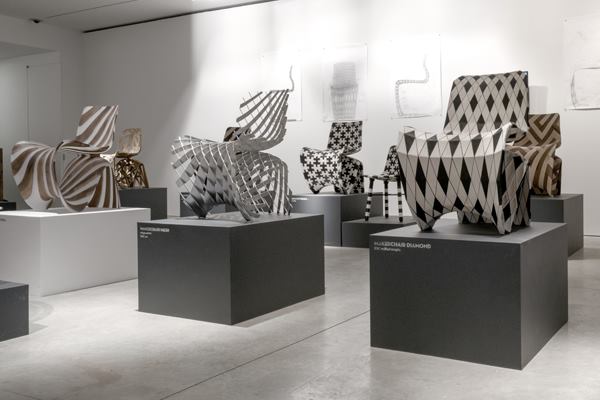Advances in digital fabrication technology are upending conventional product design processes, resulting in new methods of manufacture while expanding aesthetic potential. Nowhere is that more prevalent than in the Amsterdam studio of Dutch designers Joris Laarman and Anita Star. The self-proclaimed experimental pair works with the latest manufacturing tools, including 3D printers, CNC mills, and a novel metal-extruding arm to craft intricate pieces that mix and match solid wood, resin, plastic, and metal.
Their latest work, Joris Laarman Lab: Bits and Crafts, is on display at the Friedman Benda gallery in New York through June 17. It comprises four collections: Maker, Micro Structures, Vortex, and Spirographic.
Each of the Maker chairs is an assemblage of parametric parts that are either CNC-milled or 3D-printed to fit together like a puzzle of figurative (Jigsaw, shown), hexagonal, pixilated, and triangular pieces. But Laarman and Star aren’t keeping the design to themselves. Instead, they’re offering access to the 3D files for one of the chairs, Jigsaw (below), as a supplement to the Maker series. The 77-component chair can be fabricated in about 10 days, the team says, and with about $30 of materials. Watch as the Ultimaker 2 churns out the pieces to this literal design puzzle.
The form of the Micro Structures series of chairs is based on the relative density of cellular structures—compact where structural support is required and porous where it’s not. The Gradient Chair (shown, below) is 3D printed from thermoplastic polyurethane.
Digital algorithms that replicate the breaking of ocean waves are reinterpreted in Vortex, a duo of an aluminum bookshelf and console (show, below). The algorithms that give the furnishings their shape are inspired by the research on computational vortex methods by Mark J. Stock, who earned his PhD in aerospace engineering from the University of Michigan in 2006.
The lab’s illustrious MX3D robotic printer, developed with Autodesk, was used to create the 12-foot-long-by-8-foot-wide stainless steel Dragon Bench. The printer uses anti-gravity object printing, meaning that it can extrude metal lines in mid-air. The bench’s form derives from algorithms and non-repetitive parametric modules.
